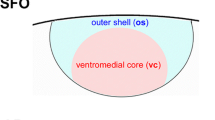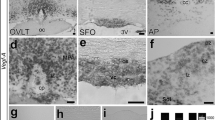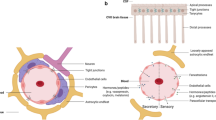Abstract
The blood-brain barrier (BBB) prevents free access of circulating molecules to the brain and maintains a specialized brain environment to protect the brain from blood-derived bioactive and toxic molecules; however, the circumventricular organs (CVOs) have fenestrated vasculature. The fenestrated vasculature in the sensory CVOs, including the organum vasculosum of lamina terminalis (OVLT), subfornical organ (SFO) and area postrema (AP), allows neurons and astrocytes to sense a variety of plasma molecules and convey their information into other brain regions and the vasculature in the secretory CVOs, including median eminence (ME) and neurohypophysis (NH), permits neuronal terminals to secrete many peptides into the blood stream. The present study showed that vascular permeability of low-molecular-mass tracers such as fluorescein isothiocyanate (FITC) and Evans Blue was higher in the secretory CVOs and kidney as compared with that in the sensory CVOs. On the other hand, vascular permeability of high-molecular-mass tracers such as FITC-labeled bovine serum albumin and Dextran 70,000 was lower in the CVOs as compared with that in the kidney. Prominent vascular permeability of low- and high-molecular-mass tracers was also observed in the arcuate nucleus. These data demonstrate that vascular permeability for low-molecular-mass molecules is higher in the secretory CVOs as compared with that in the sensory CVOs, possibly for large secretion of peptides to the blood stream. Moreover, vascular permeability for high-molecular-mass tracers in the CVOs is smaller than that of the kidney, indicating that the CVOs are not totally without a BBB.










Similar content being viewed by others
References
Arimura A (2000) Hypothalamic Hormones. In: Conn PM, Freeman ME (eds) Neuroendocrinology in physiology and medicine. Humana, New Jersey, p 43
Betz AL, Goldstein GW (1978) polarity of the blood–brain barrier: neutral amino acid transport isolated brain capillaries. Science 202:225–227
Broadwell RD, Brightman MW (1976) Entry of peroxidase into neurons of the central and peripheral nervous systems from extracerebral and cerebral blood. J Comp Neurol 166:257–283
Broadwell RD, Balin BJ, Salcman M, Kaplan RS (1983) Brain–blood barrier? Yes and no. Proc Natl Acad Sci USA 80:7352–7356
Chakravarty S, Herkenham M (2005) Toll-like receptor 4 on nonhematopoietic cells sustains CNS inflammation during endotoxemia, independent of systemic cytokines. J Neurosci 25:1788–1796
Charron G, Laforest S, Gagnon C, Drolet G, Mouginot D (2002) Acute sodium deficit triggers plasticity of the brain angiotensin type 1 receptors. FASEB J 16:610–2
Ciofi P (2009) Brain-endocrine interactions: a microvascular route in the mediobasal hypothalamus. Endocrinology 150:5509–5519
Ciura S, Bourque CW (2006) Transient receptor potential vanilloid 1 is required for intrinsic osmoreception in organum vasculosum lamina terminalis neurons and for normal thirst responses to systemic hyperosmolality. J Neurosci 26:9069–9075
Crone C, Olesen SP (1982) Electrical resistance of brain microvascular endothelium. Brain Res 241:49–55
Daneman R, Zho L, Kebede AA, Barres BA (2010) Pericytes are required for blood–brain barrier integrity during embryogenesis. Nature 468:562–566
del Valle J, Camins A, Pallàs M, Vilaplana J, Pelegrí C (2008) A new method for determining blood–brain barrier integrity based on intracardiac perfusion of an Evans Blue-Hochst cocktail. J Neurosci Meth 174:42–49
Dellman HD (1987) The subfornical organ. In: Gross PM (ed) Fine structure. In circumventricyular organs and body fluids. CRC, Boca Raton, pp 4–25, Vol. I
Dellmann HD (1998) Structure of the subfornical organ: a review. Microsc Res Tech 41:85–97
Dermietzel R (1975) Junctions in the central nervous system of the cat. Cell Tissue Res 64:45–62
Engelhardt B (2003) Development of the blood–brain barrier. Cell Tissue Res 314:119–129
Faouzi M, Leshan R, Björnholm M, Hennessey T, Jones J, Münzberg H (2007) Differential accessibility of circulating leptin to individual hypothalamic sites. Endocrinology 148:5414–23
Faraci FM, Choi J, Baumbach GL, Mayhan WG, Heistad DD (1989) Microcirculation of the area postrema: permeability and vascular responses. Circ Res 65:417–425
Fitzsimons JT (1998) Angiotensin, thirst, and sodium appetide. Physiol Rev 78:583–686
Fry M, Hoyda TD, Ferguson AV (2007) Making sense of it: role of the sensory circumventricular organs in feeding and regulation of energy homeostasis. Exp Biol Med 232:14–26
Ganong WF (2000) Circumventricular organs: definition and role in the regulation of endocrine and autonomic function. Clin Exp Pharmacol Physiol 27:422–7
Gross PM (1992) Circumventricular organ capillaries. Prog Brain Res 91:219–233
Hallmann R, Horn N, Selg M, Wendler O, Pausch F, Sorokin LM (2005) Expression and function of laminins in the embryonic and mature vasculature. Physiol Rev 85:979–1000
Harré EM, Roth J, Pehl U, Kueth M, Gerstberger R, Hübschle T (2002) Selected contribution: role of IL-6 in LPS-induced nuclear STAT3 translocation in sensory circumventricular organs during fever in rats. J Appl Physiol 92:2657–2666
Hawkins RA (2009) The blood–brain barrier and glutamate. Am J Clin Nutr 90:867–874S
Hawkins BT, Egleton RD (2006) Fluorescence imaging of blood–brain barrier disruption. J Neurosci Methods 151:262–7
Hiyama T, Watanabe E, Okado K, Noda M (2004) The subfornical organ is the primary locus of sodium-level sensing by Na, sodium channels for the control of salt-intake behavior. J Neurosci 24:9276–9281
Holmes KL, Lantz LM (2001) Protein labeling with fluorescent probes. Methods Cell Biol 63:185–204
Hornby PJ (2001) Central neurocircuitry associated with emesis. Am J Med Suppl 8A:106S–112S
Imamura Y, Morita S, Nakatani N, Okada K, Ueshima S, Matsuo O, Miyata S (2010) Tissue plasminogen activator and plasminogen are critical for osmotic homeostasis by regulating vasopressin secretion. J Neurosci Res 88:1995–2006
Krause EG, Melhorn SJ, Davis JF, Scott KA, Ma LY, de Kloet AD, Benoit SC, Woods SC, Sakai RR (2008) Angiotensin type 1 receptors in the subfornical organ mediate the drinking and hypothalamic-pituitary-adrenal response to systemic isoproterenol. Endocrinology 149:6416–24
Krisch B, Leonhard H (1989) Relationship between leptomeningeal compartments and the neurohemal regions of circumventricular organs. Biomed Res 10:155–168
Lam TK, Schwartz GJ, Rossetti L (2005) Hypothalamic sensing of fatty acids. Nat Neurosci 8:579–584
Liedtke W, Friedman JM (2003) Abnormal osmotic regulation in trpv4-/- mice. Proc Natl Acad Sci USA 100:13698–13703
Liedtke W, Choe Y, Marti-Renom MA, Bell AM, Denis CS, Sali A, Hudspeth AJ, Friedman JM, Heller S (2000) Vanilloid receptor-related osmotically activated channel (VR-OAC), a candidate vertebrate osmoreceptor. Cell 100:13698–13703
Malmgren LT, Olsson Y (1980) Differences between the peripheral and the central nervous system in permeability to sodium fluorescein. J Comp Neurol 191:103–117
Maolood N, Meister B (2009) Protein components of the blood–brain barrier (BBB) in the brainstem area postrema-nucleus tractus solitaries region. J Chem Neuroanat 37:182–195
Marin-Padilla M (1985) Early vascularization of the embryonic cerebral cortex: golgi and electron microscopic studies. J Comp Neurol 241:237–249
Michalski D, Grosch J, Pelz J, Schneider D, Weise C, Bauer U, Kacza J, Gärtner U, Hobohm C, Härtig W (2010) A novel quantification of blood–brain barrier damage and histochemical typing after embryonic stroke in rats. Brain Res 1359:186–200
Miller AD, Leslie RA (1994) The area postrema and vomiting. Front Neuroendocrinol 15:301–20
Miyata S, Hatton GI (2002) Activity-related, dynamic neuron-glial Interactions in the hypothalamo-neurohypophysial system. Microsc Res Tech 56:143–157
Miyata S, Morita S (2011) A new method for visualization of endothelial cells and extravascular leakage in adult mouse brain using fluorescein isothiocyanate. J Neurosci Methods 202:9–16
Miyata S, Takamatsu H, Maekawa S, Matsumoto N, Watanabe K, Kiyohara T, Hatton GI (2001) Plasticity of neurohypophysial terminals with increased hormonal release during dehydration: ultrastructural and biochemical analyses. J Comp Neurol 343:413–427
Morita S, Oohira A, Miyata S (2010) Activity-dependent remodeling of chondroitin sulfate proteoglycans extracellular matrix in the hypothalamo-neurohypophysial system. Neuroscientist 166:1068–1082
Mujumdar RB, Ernst LA, Mujumdar SR, Waggoner AS (1989) Cyanine dye labeling reagents containing isothiocyanate groups. Cytometry 10:11–19
Mullier A, Bouret SG, Prevot V, Dehouck B (2010) Differential distribution of tight junction proteins suggests a role for tanycytes in blood-hypothalamus barrier regulation in the adult mouse brain. J Comp Neurol 518:943–62
Murabe Y, Nishida K, Sano Y (1981) Cells capable of uptake horseradish peroxidase in some circumventricular organs of the cat and rat. Cell Tissue Res 219:85–92
Natah SS, Mouthate A, Pittman QJ, Sharkey KA (2005) Disruption of blood–brain barrier during TNBS colitis. Neurogastroenterol Motil 17:433–446
Noda M (2006) The subfornical organ, a specialized sodium channel, and the sensing of sodium levels in the brain. Neuroscientist 12:80–91
Norsted E, Gömüç B, Meister B (2008) Protein components of the blood–brain barrier (BBB) in the mediobasal hypothalamus. J Chem Neuroanat 36:107–121
Peruzzo B, Pastor FE, Blazquez JL, Armat P, Rodriguez EM (2004) Polarized endocytosis and transcytosis in the hypothalamic tancytes of the rat. Cell Tissue Res 317:147–164
Prevot V, Dehouck B, Poulain P, Beauvillain JC, Buée-Scherrer V, Bouret S (2007) Neuronal-glial-endothelial interactions and cell plascticity in the postnatal hypothalamus: implications for neuroendocrine control of reproduction. Psychoneuroendocrinology 32(Suppl 1):S46–51
Pulman KJ, Fry WM, Cottrell GT, Ferguson AV (2006) The subfornical organ: a central target for circulating feeding signals. J Neurosci 26:2022–2030
Quan N, Whiteside M, Kim L, Herkenham M (1997) Induction of inhibitory factor κBα mRNA in the central nervous system after peripheral lipopolysaccharide administration: an in situ hybridization histochemistry study in the rat. Proc Natl Acad Sci USA 94:10985–10990
Reynolds DS, Morton AJ (1998) Changes in blood–brain barrier permeability following neurotoxic lesions of rat brain can be visualized with trypan blue. J Neurosci Methods 79:115–121
Rodríguez EM, Rodríguez S, Hein S (1998) The subcommissural organ. Microsc Res Tech 41:98–123
Rodríguez EM, Blázquez JL, Guerra M (2010) The design of barriers in the hypothalamus allows the median eminence and the arcuate nucleus to enjoy private milieus: the former opens to the portal blood and the latter to the cerebrospinal fluid. Peptides 31:757–76
Rummel C, Hübschle T, Gerstberger R, Roth J (2004) Nuclear translocation of the transcription factor STAT3 in the guinea pig brain during systemic or localized inflammation. J Physiol 557:671–687
Schiller AA, Schayer RW, Hess EL (1953) Fluorescein-conjugated bovine albumin; Physical and biological properties. J Gen Physiol 36:489–506
Shaver SW, Sposito NM, Gross PM (1990) Quantitative fine structure of capillaries in subregions of the rat subfornical organ. J Comp Neurol 294:145–1152
Shekhar A, Kleim SR (1997) The circumventricular organs form a potential neural pathway for lactate sensitivity: implications for panic disorder. J Neurosci 17:9726–35
Shimizu H, Watanabe E, Hiyama TY, Nagakura A, Fujikawa A, Okada H, Yanagawa Y, Obata K, Noda M (2007) Glial Nax channels control lactate signaling to neurons for brain [Na+] sensing. Neuron 54:59–72
Sisó S, Jeffrey M, González L (2010) Sensory circumventricular organs in health and disease. Acta Neuropathol 120:689–705
Strazielle N, Ghersi-Egea JF (2000) Choroid plexus in the central nervous system: biology and physiopathology. J Neuropathol Exp Neurol 59:561–574
Szallasi A, Cruz F, Geppetti P (2006) TRPV1: a therapeutic target for novel analgesic drugs? Trends Mol Med 12:545–54
Tervo T, Joo F, Palkama A, Salminen L (1979) Penetration barrier to sodium fluorescein and fluoscein-labeled Dextrans of various molecular sizes in brain capillaries. Experimentia 35:252–254
Tominaga M, Caterina MJ, Malmberg AB, Rosen TA, Gilbert H, Skinner K, Raumann BE, Basbaum AI, Julius D (1998) The cloned capsaicin receptor integrates multiple ain-producing stimuli. Neuron 21:531–43
Wang Q-P, Guan J-L, Pan W, Kastin A, Shioda S (2008) A diffusion barrier between the area postrema and nucleus tractus solitarius. Neurochem Res 33:2035–2043
Watanabe E, Fujikawa A, Matsunaga H, Yasoshima Y, Sako N, Yamamoto T, Saegusa C, Noda M (2000) Nav2/NaG channel is involved in control of salt-intake behavior in the CNS. J Neurosci 20:7743–51
Watanabe E, Hiyama TY, Shimizu H, Kodama R, Hayashi N, Miyata S, Yanagawa Y, Obata K, Noda M (2006) Sodium-level-sensitive sodium channel Na(x) is expressed in glial laminate processes in the sensory circumventricular organs. Am J Physiol 290:R568–76
Willis CL, Garwood CJ, Ray DE (2007) A size selective vascular barrier in the rat area postrema formed by perivascular macrophages and the extracellular matrix. Neuroscientist 150:498–509
Acknowledgment
The hybridoma of anti-CD31 (2H8) antibody developed by Drs. Steven Bogen was obtained from the DSHB developed under the auspices of the NICHD respectively and maintained by The University of Iowa, Iowa City, IA 52242. This work was supported in part by Scientific Research Grants from the Japan Society for the Promotion of Science (no.21500323 to S. Miyata) and Salt Science Research Foundation (no. 1137 to S. Miyata). Shoko Morita was supported by a Research Fellowship of the Japan Society for the Promotion of Science for Young Scientists (no. 23·8513).
Author information
Authors and Affiliations
Corresponding author
Electronic supplementary material
Below is the link to the electronic supplementary material.
ESM 1
(JPEG 106 kb)
Rights and permissions
About this article
Cite this article
Morita, S., Miyata, S. Different vascular permeability between the sensory and secretory circumventricular organs of adult mouse brain. Cell Tissue Res 349, 589–603 (2012). https://doi.org/10.1007/s00441-012-1421-9
Received:
Accepted:
Published:
Issue Date:
DOI: https://doi.org/10.1007/s00441-012-1421-9




